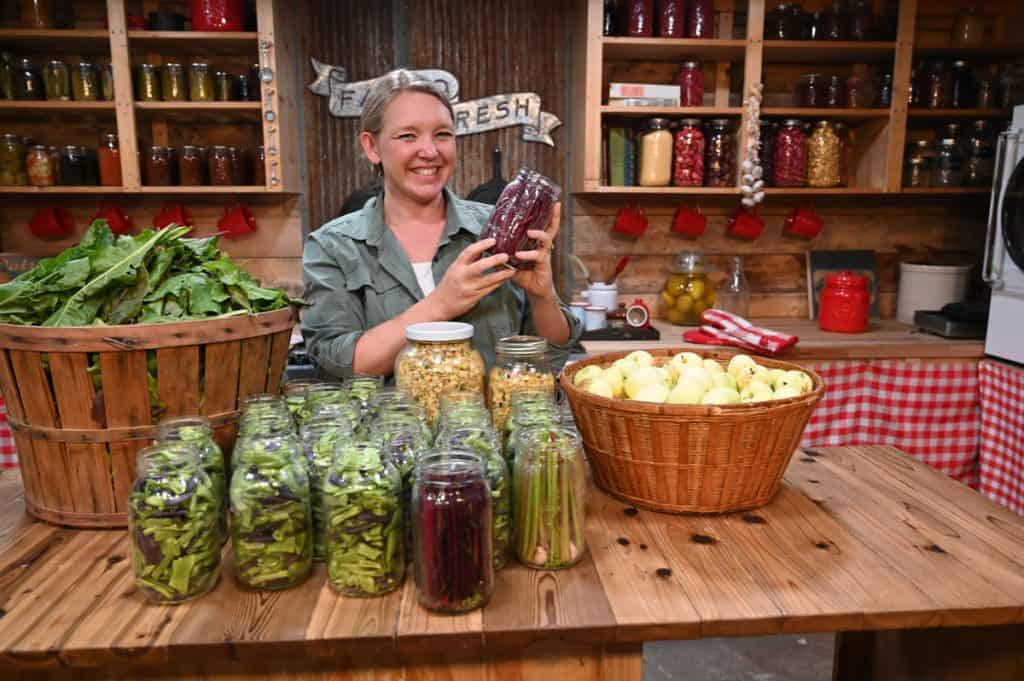


When you grow a garden and preserve the bulk of your own food, you don’t meal plan exactly like a family who is going to the grocery store for all their groceries. There are some strategies to implement when eating seasonally and meal planning on the homestead. When done correctly, seasonal eating can save a lot of time, energy and money!

Why We Love Seasonal Eating
When you’re talking about meal planning on the homestead, this doesn’t just cover dinner. Here at Riverbend we work from home, we homeschool our children, and we run a productive homestead. So we’re in need of three square meals a day that will nourish our bodies and give us the energy to accomplish all of our daily chores. It’s one of the reasons why we believe a healthy breakfast is so important.
However, it’s only been in the past century that we’ve come to the idea that we can eat whatever food we want, no matter the season. Our great-great-grandparents weren’t eating fresh tomatoes in December. They were eating what was still growing in the garden or what they’d preserved from that year’s harvest.
We are fortunate to raise the majority of our meat here on Riverbend (with some hunting layered in), so we don’t have to think about purchasing that from the grocery store. You can learn how to raise a year’s worth of meat and also how much land is needed to raise a year’s worth of meat (hint: it’s less than you might think).
How to Meal Plan for Eating Seasonally
Before making a meal plan, especially if you want to eat seasonally and cook from scratch, you should always start by asking yourself three questions.
- What do I have that’s fresh?
- What do I have in storage that needs to be eaten quickly before it turns or goes bad?
- What do I not have very much of and need to use sparingly?
This will vary depending on the time of year, but it’s important to take stock of what’s growing and ready to be harvested in the garden, what fresh food has already been harvested that needs to be used up before it goes bad, or what foods have been preserved and need to get consumed before the next spring/summer preserving season.
This may look different throughout the year. Right now, while the garden is producing, I always walk through the garden to see what needs to be harvested. Taking inventory of the fruits and vegetables that are ready to harvest means they won’t go bad before there’s a plan to eat them up.
If we’re not actively gardening, I’m walking through the pantry and the makeshift root cellar to see what needs to be used up. As we get closer to the growing season, I’m looking at my food stores to see what we should use up before fresh seasonal produce is ready for harvest again.
If you’re not growing a garden, consider going to your local Farmer’s Market and doing your meal plan after coming home with your finds. Or, if you’re a member of a local CSA, you could ask what seasonal food is going to be in your basket that week and make your plan based on the produce included.
We think buying local fresh food harvested at the peak of ripeness (ideally following organic, natural growing methods) is best. This doesn’t include the grocery store!
Once you have answered those three questions, no matter where you are in the season, you can then begin to plan your weekly meal plan.
Eating at the Peak of the Season
Sometimes you have an abundance coming from the garden; this tends to happen with zucchini here at Riverbend. (We use the extra to make zucchini pickles, delicious zucchini cake, zucchini blossoms or zucchini flour from our freeze-dried zucchini.)
Sometimes what you have an abundance of will be canned, freeze-dried or put into the freezer for future preservation. But eating as much of that produce as you can while it’s fresh means you’re getting the most nutrients possible (and the best flavor).
I find that eating fresh, high-quality produce requires less fuss for cooking. Less fuss for cooking means less time spent in the kitchen. So eating seasonally really can save you time and money.

Planning Dinner on the Homestead
Continually taking inventory of your food supply on a weekly (sometimes daily) basis will help you keep track of your garden, the harvest schedule, and your preserved food stores.
Keeping close tabs will help you plan and stretch those preserved items out so they last all year long. This method will also minimize what you need to supplement from the grocery store.
What type of meal?
For dinner, one of our biggest tips is to first figure out “what type of meal” we’re going to have. This is figured out after you answer the three questions above, but can sometimes help you figure out how to use what you have.
We typically break down our week in a very basic manner that looks something like this:
- Mondays = Pasta (Try this Quick & Delicious Creamy Leek Pasta.)
- Tuesday = Soup (Greek Lemon Chicken Soup is a weeknight winner.)
- Wednesday = Stir fry (Usually some kind of garden stir fry with whatever veggies are coming in.)
- Thursday = Roast chicken (Try my Lemon Reduction Sauce With Roasted Chicken.)
- Friday = Pizza (We love easy homemade sourdough pizza crust with the best pizza toppings.)
- Saturday = Roast Beef
- Sunday = Burgers or Tacos

No matter what the meal, depending on what time of year it is determines whether I’m grabbing fresh produce from the garden, frozen veggies from the freezer, or canned, dehydrated, and freeze-dried food from the pantry.
For example, if it’s springtime, we will have fresh greens, asparagus and peas. I can make asparagus soup and pasta primavera with some of my homemade egg noodles, pair it with whatever meat needs to be used up and call it a meal.
If it’s the dead of winter and there’s not a fresh vegetable in sight, then we’ll utilize some of our freeze-dried vegetables, home-canned black beans, and canned bone broth to make up a soup, stew, or chili.
Or maybe it’s our dehydrated tomatoes, dried herbs, and homemade farm cheese for pizza night.
Another tip to keep your family eating seasonally is to plan ahead for those days when life doesn’t go as planned and you don’t have time to get a home-cooked meal on the table. That’s when we reach for items like our ready-to-eat canned beef stew, homemade chicken chili, easy freezer meals, or even pressure-canned beef or pressure-canned chicken that’s sitting on the pantry shelf, just waiting to save the day!

The Challenge With Gardening
When you get serious about eating seasonally and utilizing what you’re growing in the garden, one of the biggest challenges, at least for us, was learning how to feature those ingredients you’re growing in your meals so you actually start seeing the grocery budget go down.
Our big go-to recipes to utilize the garden produce are soups, salads, and stir fry. There’s just no end to the creativity with them and they’re a great way to “use what you have.”
It’s really fun to get the rice started for a stir fry, then to go “grocery shopping” out in the garden for the rest of the meal! We’ve learned not to assume certain vegetables won’t pair well together until we’ve tried it at least once. We’ve found some really delicious combinations this way!

Always Keep Basic Staples On Hand
There are certain pantry staples I’ll never be without. Having my pantry stocked makes most meals easy and readily available to make because I have my basics taken care of.
No meal is off limits when your pantry is well stocked (click here to learn how to build up a well-stocked pantry!).

Planning Easy Doable Breakfasts
Hopefully, by now you’ve grabbed my easy breakfast casserole recipes (if not, click that link and grab them now!). We make breakfast casseroles almost every day of the week. They’re just so simple to prep at the beginning of the week, then keep them in the refrigerator until the morning they need to be baked.
Most of our breakfast casseroles include basic pantry staple ingredients, but then can be adjusted seasonally based on what’s in season, what we’ve canned up, or even what’s frozen, dehydrated, or freeze-dried from last year’s harvest.
For example, the baked oatmeal recipe calls for basic pantry staples, then throughout the year, we’ll add canned peaches, fresh strawberries, frozen blueberries, freeze-dried raspberries, or even dried coconut flakes and nuts mixed in for different flavors.
Having quick grab-and-go breakfast items like a healthy instant breakfast mix or homemade yogurt and fresh fruit is also a great idea for those who need a quicker option. These can be assembled in a jar the night before so they’re ready to eat quickly the next morning.
Get creative and do what works best for your family.

Quick and Easy Lunches
Our biggest tip for getting clean, healthy, and seasonal lunches on the table every day is to make enough dinner that you have leftovers the next day. We love the motto “cook once, eat twice” and it’s certainly a time-saver for a busy household.
When we have fresh greens (we’re excited to be able to grow greens year-round now), we’re big on having a nice green salad nearly every day for lunch. A big salad really helps stretch the leftovers so everyone gets enough to eat. What goes in the salads depends on what else is in season!
Another great lunch addition that helps stretch those leftovers is to have a fresh loaf of bread to slice and add some homemade butter to make a meal a little more substantial. We love our easy five-minute no-knead artisan bread as it’s simple to quickly bake in the morning and have it still slightly warm at lunchtime. (Another favorite is our sourdough parker-house rolls recipe!)
If leftovers don’t sound appealing to you, when you have homemade bread, you can easily make a quick peanut butter and jelly sandwich, a chicken salad sandwich, easy bread soup, or grilled cheese.
We understand this method of meal planning is different than the typical way where you decide what you want to eat, make your list of groceries, then go buy everything needed from the store. This method is a much more seasonal approach.
It’s also a great way to help you plan out your homesteading year by taking inventory of the foods your family enjoys, and learning how much of each item your family eats to know how much you need to grow, harvest, and preserve to use throughout the year.
We hope this has been helpful for you to learn how to get healthy home-cooked meals on the table every single day without needing to run to the grocery store!



















